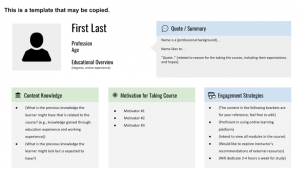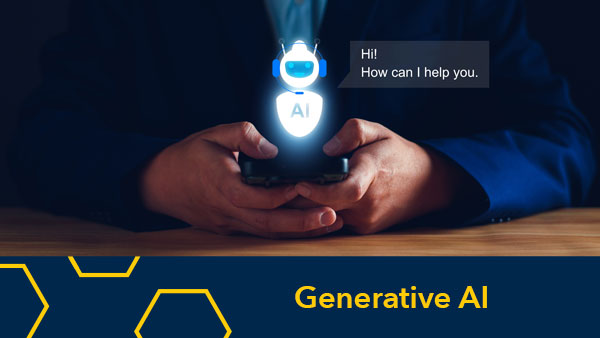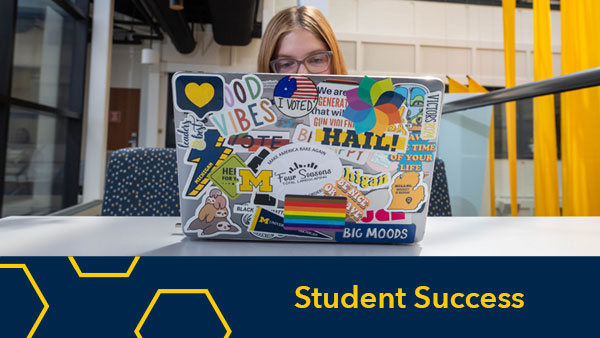Yuanru Tan, Learning Experience Designer and Accessibility Coordinator
Rebecca M. Quintana, PhD, Learning Experience Design Lead
Stephanie Haley, User Experience Research Lead
Nathan Magyar, User Experience Designer
At the Center for Academic Innovation, opportunities abound for Learning Experience Designers (LXDs) and User Experience Designers to collaborate on shared projects and to exchange resources and methods. This situation allows for cross-disciplinary approaches to emerge. In this first blog post of two, we focus on how a UX method—that of persona creation—has become an integral part of the learning experience design process at Academic Innovation. We then introduce a new approach we have developed called the Asynchronous Persona Creation Activity that allows faculty collaborators to become more deeply involved in the persona creation process, even before the design process begins.
In the context of user-centered design, personas are fictional representations of potential users. They offer a realistic portrait of a user that can be used at critical junctions in the design process, such as when a feature decision needs to be made. While personas have not seen their way to many educational design contexts, they hold particular promise for describing potential MOOC learner audiences. Since MOOC audiences tend to be more diverse and much larger than other learning contexts, personas provide clarity and focus. Learner personas can describe the backgrounds, experiences, motivations, and challenges of different types of learners and are based on information from the instructor, aspirations that the instructor has for the course, and data collected from similar courses (Quintana et al., 2017).
Learner Personas at Academic Innovation
In 2017, Academic Innovation hosted an internal Persona Party where 19 team members were given the task of creating Learner Personas for the use in future iterations of an online course. The 19 individuals were divided into four groups and provided with the materials needed to create Learner Personas: 1) demographic data from pre-course surveys, 2) a persona design template, and 3) background information about the instructor’s goal for the course, including the audience they hoped to reach. Through sketching and discussion, the four groups produced nine unique Learner Personas. The Persona Party event was designed and led by Stephanie Haley, User Experience Research Lead.
This pivotal event informed persona creation for courses that were subsequently designed In conversation with faculty innovators, LXDs developed and refined learner personas, following the design template introduced at the Persona Party.
Introducing the Asynchronous Persona Creation Activity
In 2019, we developed a new approach called the Asynchronous Persona Creation Activity. In advance of design meetings, faculty members work through a customized digital workbook that includes useful resources:
- Step-by-step guidelines for creating learner personas
- Reflection prompts to help faculty think through potential learner audiences:
- What is the learner’s goals for taking the course? How might they benefit from taking the course? What are their strengths? Where might they struggle?
- A template consisting of five categories:
- Demographic information (age, profession, and education background).
- Current knowledge about the course topic.
- Motivations for taking the course.
- Engagement strategies for participation in the course (e.g., planned time commitment)
- Fictional self-introduction quote from the persona’s point of view.
- A selection of profile photos and a link to a name generator
- Exemplar learner personas
The desired process and outcome of the Asynchronous Persona Creation Activity is twofold:
- Sketch out characteristics of representative types of learners, such as demographic information, previous domain knowledge, motivation for enrolling in a course, and engagement strategies when taking a course;
- Establish a shared referent of a prototypical learner to support future design decision making, including defining learning outcomes, setting the “rigor” level of a course, and creating activities and assessments that are aligned with learning outcomes.

After the Asynchronous Persona Creation Activity is complete, the course design team meets in person to discuss the learner personas created by the faculty member. LXDs facilitate a discussion where they might ask the following questions: What are the overlaps between the persona’s prior knowledge and the course content we are going to develop? What expectations does the persona have concerning course content that are not in our design yet? Through discussion, the course design team refines the details of the learner personas as needed and aims to define a shared referent to communicate future design decisions.
Reflections
At Academic Innovation, LXDs have implemented the Asynchronous Persona Creation Activity with multiple design teams in different subject domains, such as extended reality, mobility and transportation, and data science. This approach allows faculty to work independently and asynchronously (i.e., on their own time, rather than in a group setting), on a schedule and at a pace that works best for them. This approach leverages the instructional expertise of faculty and encourages them to reflect on the persona creation process before sharing their vision with the wider project team. Through the several Asynchronous Persona Creation Activities we have done with faculty, we have found that the follow-up discussions were very thoughtful and productive. Not only is the persona itself a valuable asset to inform future design decision-making, the process of creating a persona from abstract thoughts to a fleshed out learner persona helps faculty build empathy with potential audiences, which could further help them create an inclusive and welcoming course. As LXDs, we recognize the important role played by learner personas throughout the design process. We look forward to experimenting with more approaches to create and use learner personas with our design teams!
Reference
Quintana, R. M., Haley, S. R., Levick, A., Holman, C., Hayward, B., & Wojan, M. (2017, May). The Persona Party: Using Personas to Design for Learning at Scale. In Proceedings of the 2017 CHI Conference Extended Abstracts on Human Factors in Computing Systems (pp. 933-941). ACM.


